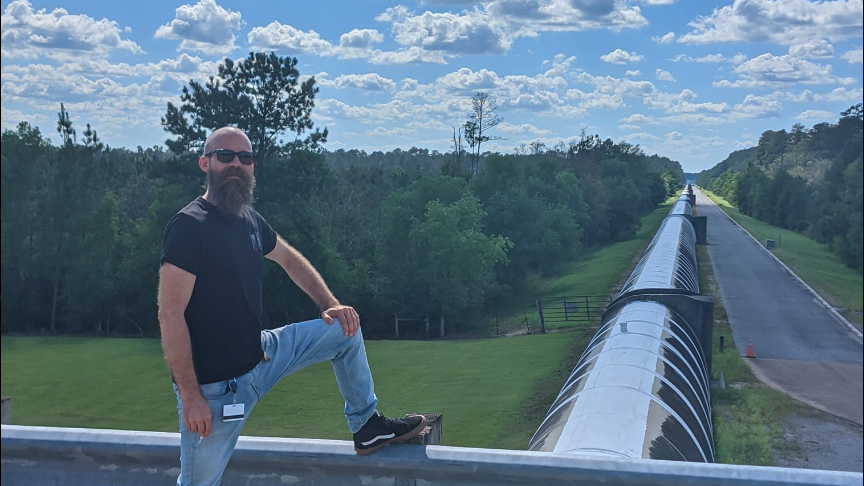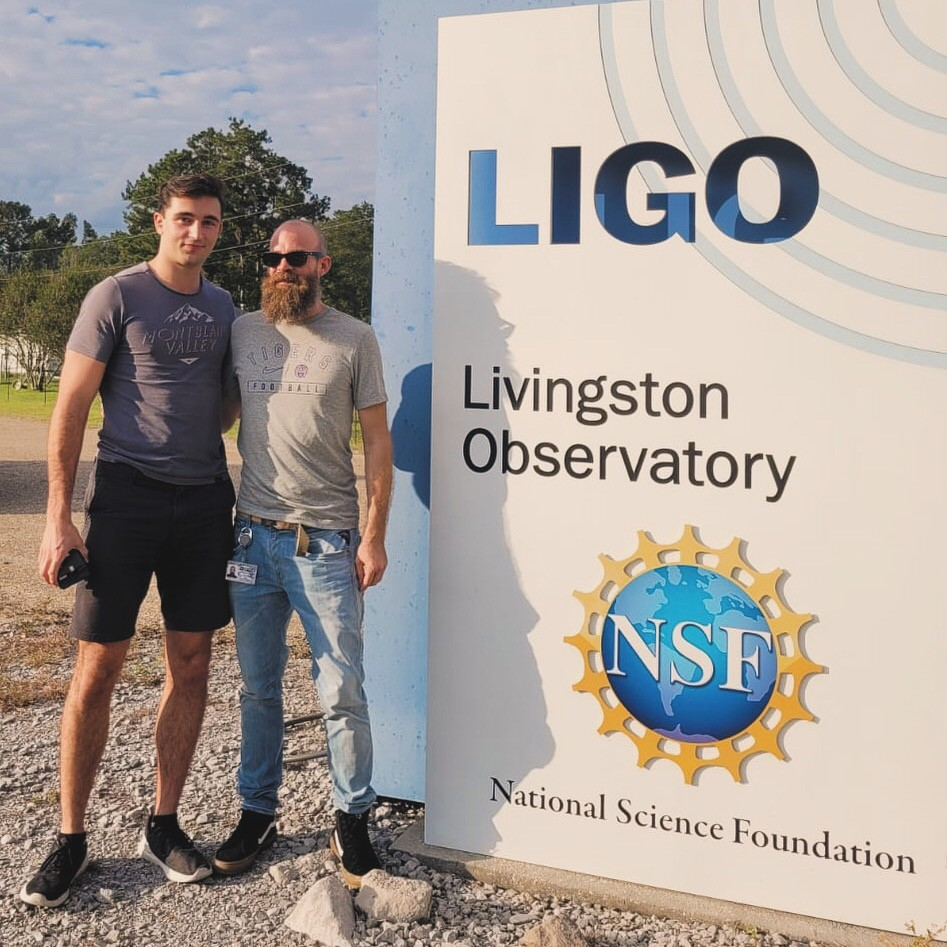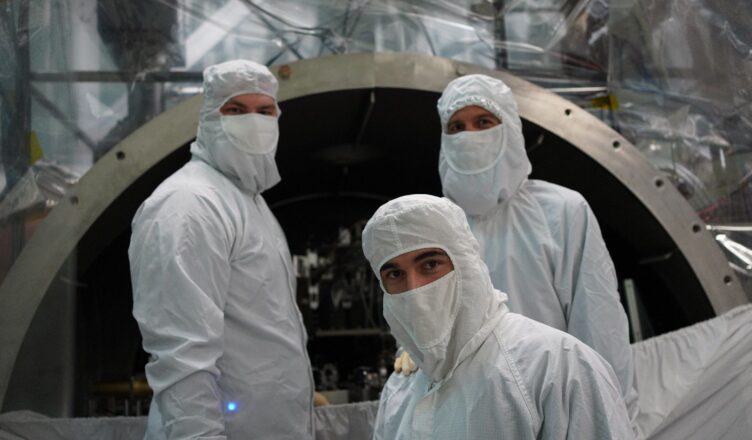On December 21, 2024, researchers Rafel Jaume Amengual and Joan-René Mérou Mestre, of the Institute of Applied Computing and Community Code (IAC3) at the University of the Balearic Islands (UIB), returned from a three-month research stay at the Laser Interferometer Gravitational-Wave Observatory (LIGO) in Livingston, Louisiana, USA. Their stay was part of their PhD program as members of the LIGO Scientific Collaboration (LSC) as part of the LIGO Fellow program, focused on detector characterization tasks to enhance the observatory’s sensitivity to gravitational waves.
What Are Gravitational Waves?
Gravitational waves are ripples in spacetime that travel at the speed of light, caused by accelerating objects. Predicted by Albert Einstein’s general theory of relativity in 1915, these waves propagate outward from events like merging black holes, neutron star collisions, or other highly energetic cosmic phenomena. These ripples carry information about the cataclysmic events that created them, offering a new way to study the universe.
However, detecting these waves is incredibly challenging due to their very small effects. They cause distortions on the scale of one ten-thousandth the diameter of a proton. To detect these tiny distortions, scientists have developed highly sensitive instruments like LIGO, which use advanced laser interferometry.

How Does LIGO Work?
LIGO operates two observatories in Hanford, Washington, and Livingston, Louisiana. Each facility houses a massive interferometer with two perpendicular arms, each 4 kilometers long. A laser beam is split in two and travels down each arm, reflecting off mirrors and recombining at a photodetector.
When a gravitational wave passes through, it stretches and compresses the arms slightly, creating a shift in the laser beams’ phase and producing measurable interference patterns. This change, though extraordinarily small, is detectable by LIGO’s sensitive instruments.
To achieve such precision, LIGO must operate in an environment free from noise. This includes not only seismic vibrations but also other sources of noise, such as electrical interference, temperature fluctuations, and even the effects of human activity. Ensuring the quality of LIGO’s data is the primary goal of the Detector Characterization team, to which Rafel Jaume Amengual and Joan-René Mérou Mestre contributed.

The Role of Detector Characterization
Gravitational-wave detectors are incredibly sensitive, which means they are also susceptible to a wide variety of noise sources. The Detector Characterization team plays a vital role in identifying and mitigating these noise sources. Their work ensures that data collected by LIGO is accurate and free from artifacts that could mimic or obscure gravitational-wave signals. Detector characterization focuses on three main areas:
- Preparing for observing runs by improving data quality tools and automating signal validation processes.
- Supporting detector upgrades and commissioning, ensuring each subsystem operates optimally.
- Monitoring and maintaining data quality during observing runs, identifying noise sources and artifacts in real-time to aid astrophysical searches.
Contributions by Rafel Jaume Amengual and Joan-René Mérou Mestre
During their three-month research stay at LIGO Livingston, both Rafel Jaume Amengual and Joan-René Mérou Mestre worked closely with Dr. Anamaria Effler and the site staff as part of the Detector Characterization team. Their work focused on improving the detector’s sensitivity, identifying and mitigating noise sources, and contributing to real-time follow-ups of gravitational-wave candidate events during the fourth observing run (O4). Each researcher undertook distinct projects that advanced LIGO’s capabilities.

Rafel Jaume Amengual’s Work
Rafel’s efforts focused on improving LIGO’s data acquisition systems, particularly the Analog-to-Digital Converters (ADCs). These devices are responsible for converting the analog signals from LIGO’s sensors into digital data for analysis. His contributions included:
- ADC Crosstalk Analysis: Investigating how interference between ADC channels could distort data, a critical issue for precision systems like LIGO, with findings highlighting the importance of isolating channels to ensure data accuracy.
- DuoTone Signals for Calibration: Working with DuoTone signals, which serve as timing witnesses in the data stream, ensuring sub-microsecond timing precision for aligning the interferometer’s output with UTC standards.
- Calibration Improvements: Emphasizing the need for precise calibration to quantify LIGO’s response to gravitational waves, reducing biases in measurements of black holes and neutron stars and ensuring reliable scientific conclusions.
In addition to these tasks, Rafel collaborated on noise investigations and contributed to analyzing data quality during candidate gravitational-wave events. He also participated in gravitational-wave candidate Rapid Response Team (RRT Level 0) shifts, supporting real-time validation of gravitational-wave candidates and analyzing noise events.

Joan-René Mérou Mestre’s Work
Joan-René focused on identifying and mitigating noise issues that had been challenging detector scientists for months. He also contributed to rapid follow-ups of gravitational-wave candidate events detected during the fourth observing run (O4). His contributions included:
- Broadening of 60 Hz Shoulders: He identified a calibration issue causing contamination near the Crab pulsar frequency. His investigation revealed that the noise broadening occurred due to a subtraction artifact in calibration signals, resolving a longstanding problem.
- Lock Loss Logging: He implemented an automated system to log power and detector activity during lock loss events. This system proved critical for ensuring instrument safety and improving operational diagnostics.
- 9.5 Hz Comb Mitigation: He confirmed the successful mitigation of a noise artifact originating from electronics in the pre-stabilized laser racks, improving the detector’s performance.
- 11.11 Hz Comb Noise Investigation: By analyzing data from multiple channels, Joan-René traced a persistent noise source to vacuum rack electronics, providing significant insight into this artifact.
In addition, Joan-René participated in gravitational-wave candidate Rapid Response Team (RRT Level 0) shifts, supporting real-time validation of two gravitational-wave detections: 241113p and 241116cq, two coalescences of binary black hole systems. Following the validation of the gravitational-wave candidates, Joan-René sent circulars to the wider worldwide scientific community through NASA’s General Coordinates Network.

Why their work matters
Both researchers contributed to advancing LIGO’s capabilities during its fourth observing run (O4). The insights and tools they developed will be useful for current and future gravitational-wave detections. By addressing specific noise issues and enhancing the quality of the detector’s data, they have ensured more reliable astrophysical observations.
Their work exemplifies the importance of collaborative international research in fields like gravitational-wave astronomy. The advancements made during their stay not only improve LIGO’s performance but also pave the way for new discoveries about the universe.











